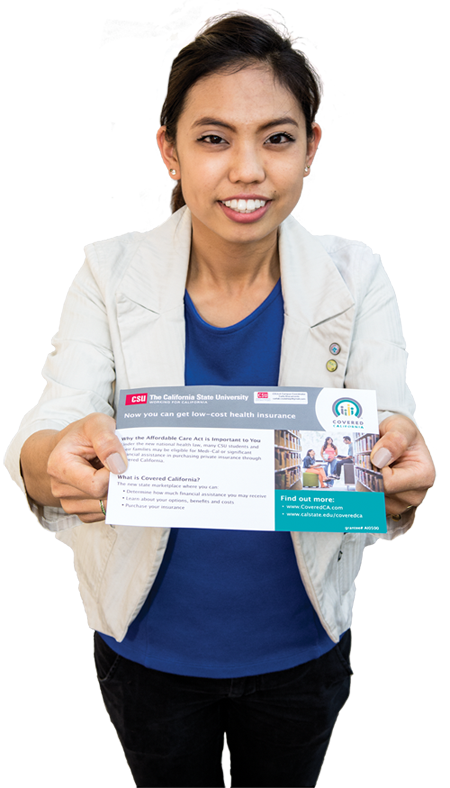Set spin aside. Cal State L.A. team leads effort to educate students about options under historic health care law
Walter Zelman is a man only looking for five minutes of your time.
That, he says, is the most effective way to link Cal State students to the new options available through Covered California, the state’s health insurance exchange.
Zelman is charged with overseeing 30 workers who implement the $1.25 million Covered California Outreach and Education effort for the California State University system. Housed in Cal State L.A.’s Department of the Public Health, of which Zelman is chair, the CSU Health Insurance Education Project spans 15 CSU campuses.
It’s the largest such outreach grant in the program, because in order for the Affordable Care Act to be effectively implemented the number of young people signing up needs to increase. And Cal State students are a prime demographic.
“We have a population that’s disproportionally young, disproportionally Latino, and disproportionally low-income, so it wasn’t hard to figure out that we’d have many students eligible under Covered California,” says Zelman.
A recent poll of three CSU campuses indicated that about 30 percent of college students are uninsured, with many of them citing cost as the primary reason. But many students are eligible for financial assistance through expansion of Medi-Cal under the new law, says Zelman.
“The prices in covered California for our students are very good…. And about 70 percent of CSU students are either eligible for Medi-Cal—which is free—or subsidies in the healthcare exchange.”
But the goal of the CSU Health Insurance Education Project is not enrollment—it’s education and awareness.
Much has been said in the media about the Affordable Care Act and trying to break through that din—and get students to hear the facts and understand health insurance—is a challenge.
“People our age don’t really think about health insurance,” says Natasha Buranasombati (’13), Cal State L.A.’s campus coordinator. “So we have to educate them about a new topic and get them to understand deductibles and co-payments—it’s really complicated. For some students, this is the first time they’re hearing it.”
That’s why the project has hired and trained current students and recent alumni like Buranasombati (PICTURED), who graduated with a bachelor’s degree in public health, to lead the information sessions. Peers are more relatable and provide credibility to the effort, she says, so students are more attentive and are more likely to ask questions.
During pitches, Buranasombati likes to explain how she was taken off her parents’ insurance in her senior year. She handled most of her medical issues at the Student Health Center, but was lucky to avoid any accidents or costly hospital stays. During the training and preparation for the project, she became educated about the health insurance process, enrolled in a plan through Covered California and has been insured since Jan. 1.
“In classroom presentations, we show some numbers about how much it would cost to go to the emergency room and I hear people gasp. Some people might push back, but they generally understand it’s really important to be insured. It’s like car insurance, if you get into an accident, the bill isn’t going to be hundreds of dollars, it’s going to be thousands,” she says.
Additionally, recent alumni and current students are more familiar with campus services than outsiders, and many already have established relationships with student health centers, Associated Students, Inc., and faculty.
“The strategy we found most effective on campuses is getting into classrooms and getting the undivided attention of the students, even if it’s just for five minutes,” says Zelman. “So on all the campuses we’ve had major efforts to outreach to the faculty to get our student coordinators into their classrooms to make a presentation.”
So far, the faculty has been receptive. Campus coordinators at Cal State L.A. have visited 10 to 12 classrooms each week since September, Buranasombati says.
“I invite Dr. Zelman’s coordinators into my classroom. And I tell my students: This is important. This is your future. You’ve got to listen up and take action,” says Kevin Baaske, professor of communication studies and chair of the Academic Senate.
But Zelman’s team won’t just be in classrooms. This is an all-hands-on-deck problem that calls for an all-of-the-above response. So the team is tabling and posting flyers on the CSU campuses, partnering with student government and organizations, and hosting campuswide forums on Covered California.
Luckily, they’re not alone.
According to Covered California Public Information Officer Roy Kennedy, Zelman’s efforts are part of a broader strategy to recruit the so-called “young invincibles.”
“We have a Millennial marketing campaign using traditional social media—that’s Facebook, Twitter and Instagram,” says Kennedy. “We also have a shop-and-compare mobile application, a Facebook app, and a commercial called ‘Bump in the Road.’ In the ad, a young man wipes out on a mountain bike and is in need of unexpected health care.”
Between their efforts, Zelman and Kennedy hope to educate and incentivize students into getting serious about their health care needs.
So far, Covered California considers their efforts a success.
In fact, on Feb. 19, the organization announced it met the 2014 enrollment goals—six weeks ahead of schedule. And as of March 17, more than 1 million people had signed up for Covered California with an estimated 26 percent of them below the age of 34. An additional 877,000 are newly eligible for Medi-Cal.
This is great news to Zelman and his team in Los Angeles—a region he considers to be the heart of the uninsured problem.
“This community around Cal State L.A. has probably the highest number of uninsured people in the country. Besides, perhaps, pockets of Texas.”
Whether or not the Affordable Care Act is effectively implemented remains to be seen, as patients are currently in the first several months of coverage.
However one thing’s for sure: as the March 31 deadline approached, the team wasn’t slowing down in the homestretch. Instead, they were asking students for five minutes of their time.
